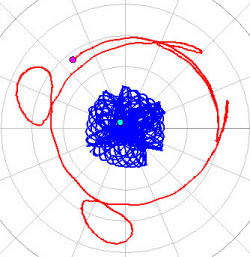
Orbits of two electrons in a classical helium atom model from Chapter 5: Few Body Problems.

Orbits of two electrons in a classical helium atom model from Chapter 5: Few Body Problems.
Every programming language requires tools, such as editors and compilers, to produce and distribute ready to run programs. These tools are often
integrated into development environments with graphical user interfaces, such as Eclipse, that provide easy access to the underlying tools. We have
chosen Easy Java Simulations for this edition of An Introduction to Computer Simulation Methods because its dynamic and highly interactive user
interface greatly reduces the amount of programming required to implement an idea. EJS is a Java program that enables both programmers and novices to quickly
and easily prototype, test, and distribute packages of Java simulations. EJS gently introduces students to Java syntax but even experienced programmers find it
useful because it is faster and easier to:
The advantage of EJS for computational physics teaching is that it forces us to separate the model into logical parts and to separate the model from the view. Students learn the logic of computer modeling using loops and control structures and study algorithms used in professional practice when building models. Students are also introduced to object-oriented programming concepts by using object properties and methods when they create user interfaces. However, little user-interface coding is required because the user interface code is created automatically by EJS. A button click is all that is required to produce a stand-alone ready-to-run computer program that implements the model.
The following chapters are a draft EJS adaptation of An Introduction to Computer Simulation Methods by Harvey Gould, Jan Tobochnik, and Wolfgang Chrsitan.